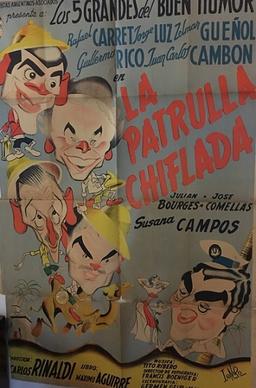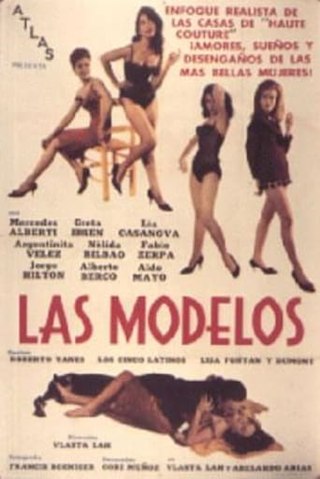Related Research Articles

The Soul of the Accordion is a 1935 Argentine tango musical film directed by Mario Soffici and written by José A. Bugliot. It is considered one of the earliest classics of Argentine cinema.
The National Institute of Cinema and Audiovisual Arts was an agency of the Government of Argentina. It promotes the Argentine film industry by funding qualified Argentine film production companies and supporting new filmmakers. The Institute was established on 14 May 1968 by law nº 17.741. The INCAA also organizes the Mar del Plata International Film Festival, Ventana Sur film market, and has its own film school called ENERC.

The Newsie and the Lady is a 1938 Argentine comedy film directed and written by Luis César Amadori.

Elvira Fernández, vendedora de tiendas is a 1942 Argentine comedy film directed by Manuel Romero. It stars Paulina Singerman, Juan Carlos Thorry, Tito Lusiardo and Sofía Bozán. The film is about the daughter of a millionaire store owner, who organizes a worker strike.
El fin de la noche is a 1944 Argentine film. It is notable for being an anti-Nazi film made in neutral Argentina during World War II and set in occupied France. Shot from August to November 1943 in Cordoba Province, the release was put on hold for more than a year, pending authorization by the pro-Axis military government of that time. The film is also remembered in Argentina for Libertad Lamarque's performance of the tango Uno, composed by Mariano Mores and Enrique Santos Discépolo.

La Patrulla chiflada is a 1952 Argentine adventure comedy film set in Africa, directed by Carlos Rinaldi and featuring the Los Cinco Grandes del Buen Humor group of comic actors. It stars Rafael Carret, Jorge Luz, Zelmar Gueñol, Guillermo Rico and Juan Carlos Cambón.

School of Mermaids and Sharks is a 1955 Argentine film directed by Enrique Carreras and starring Amelia Vargas, Alfredo Barbieri, Esteban Serrador and Leonor Rinaldi. The film was released on 4 August 1955. Enrique Carreras remade the film in 1982 under the title Los fierecillos indomables, starring Alberto Olmedo and Jorge Porcel in the lead roles.
Cinco gallinas y el cielo is a 1957 Argentine science-fiction drama film directed by Uruguayan-born filmmaker Ruben W. Cavallotti, written by Agustín Cuzzani and starring Narciso Ibáñez Menta. The film won awards at the international festivals of Karlovy Vary and San Sebastian.
Juegos de verano is a 1973 Argentine erotic film directed by Juan Antonio Serna and starring Linda Peretz and Ricardo Morán.

Los golpes bajos is a 1974 Argentine film directed by Mario Sábato. It is a film about boxing, inspired by José María Gatica. Shot in Eastmancolor, Sabato wrote the script in collaboration with Mario Mactas. The film stars Aldo Barbero, Héctor Alterio, Walter Vidarte and Ana María Picchio.

El grito de Celina is a 1983 Argentine romantic drama film directed by Mario David, who also wrote the script, which is based on a short story by Bernardo Kordon. It stars María Rosa Gallo, Selva Alemán, Miguel Ángel Solá and María Vaner. Víctor Proncet composed the soundtrack. The film was shot in 1975, but it didn't premiere until May 1983 due to military government disapproval and censorship at the time.

Jorge Salcedo was a popular Argentine actor of radio, television and feature films, who appeared in film between 1941 and 1980.

La rubia del camino is a 1938 Argentine romantic comedy written and directed by Manuel Romero. Actress Paulina Singerman made her debut in the film.

The Englishman of the Bones is a 1940 Argentine drama film based on a novel of the same name.

El tesoro de la isla Maciel is a 1941 Argentine comedy film directed by Manuel Romero.
Aurelia Del Carmen Guarini is an Argentine anthropologist, teacher, film director, and film producer specializing in anthropological documentary films. She teaches visual anthropology and directs documentaries in Argentina and in Cuba. She serves on the documentary projects' evaluation committee at the National Institute of Cinema and Audiovisual Arts and participates in Cine Ojo projects.
Historias breves is an Argentine feature-length film made up of nine short films directed, respectively, by Daniel Burman, Adrián Caetano, Jorge Gaggero, Tristán Gicovate, Andrés Tambornino and Ulises Rosell, Sandra Gugliotta, Lucrecia Martel, Pablo Ramos, and Bruno Stagnaro. It debuted in theaters on May 19, 1995.
Edgardo Togni was an Argentine film producer and director who worked in his country from the 1940s to the 1960s and founded the Directores Argentinos Cinematográficos.
Mario David was an Argentine film director and screenwriter. He directed and wrote 12 films between 1971 and 1996.

Las modelos is a 1963 film directed and written by Vlasta Lah, the first woman director of sound films in Argentina and the only woman filmmaker in 1960s Latin America. It was her second and last film, released after her 1960 directorial debut Las furias. The film tells the story of Sonia and Ana, two young haute couture models, who are played by two real-life models instead of actresses.
References
- Manrupe, Raúl; Portela, María Alejandra (2001). Un diccionario de films argentinos (1930-1995). Buenos Aires, Editorial Corregidor. pp. 280–281 y 741. ISBN 950-05-0896-6.